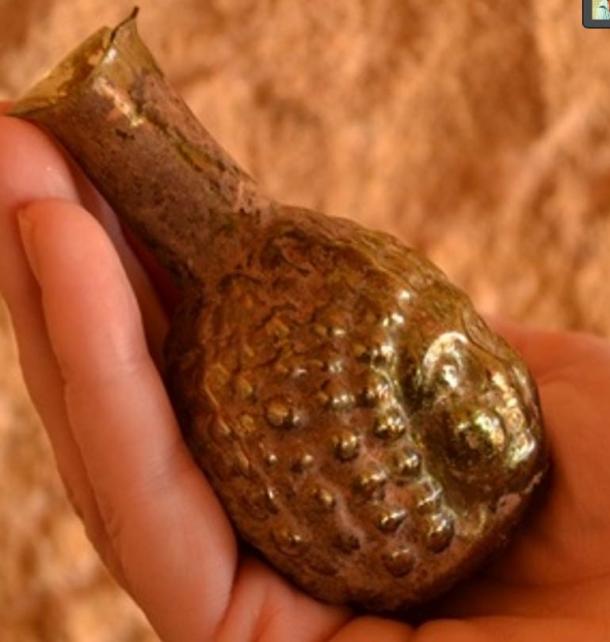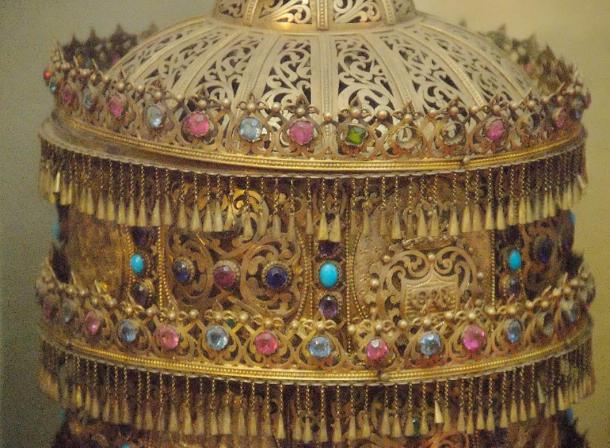
Amazing jewels and artifacts found in 2,000-year-old Ethiopian grave reveal link to Rome
A major excavation carried out in the ancient city of Aksum in northern Ethiopia has yielded stunning treasures from both the Roman empire and Aksumite kingdom, revealing a connection with the Romans hundreds of years earlier than previously believed.
The Guardian reports that the “extraordinary” relics were unearthed in a series of graves dating back to the 1 st and 2 nd centuries. The artifacts include luxurious items of jewelry, such as a necklace made of thousands of tiny colored-glass beads; a beaded belt, Roman glass vessels, drinking beakers, a flask, clay jug, iron bangles, a glass perfume flask, and a Roman bronze mirror.

Perfume flask found at the site. (The Guardian)
The Kingdom of Aksum was a trading nation that flourished between 100 and 940 AD. At its height, the Empire extended across most of present-day Eritrea, northern Ethiopia, Western Yemen, southern Saudi Arabia and Sudan. The capital city of the empire, also called Aksum, was based in what is now northern Ethiopia, and was once a wealthy metropolis, cultural and economic center.
Aksum was a major player in the commercial route between the Roman Empire and Ancient India, exporting ivory, tortoise shell, gold and emeralds, and importing silk, spices, and other goods.
- Tracing the origins of a mysterious ancient Queen of Ethiopia
- The Intricately Carved Tiya Megaliths of Ethiopia
- The Incredible Rock-Hewn Churches of Lalibela, Ethiopia

The Kingdom of Aksum was ideally placed to trade with both ancient India and the Roman Empire (Wikimedia Commons)
Historical and archaeological records have shown that the Aksumite Empire was trading with the Romans at least as early as the fourth and fifth centuries. However, the latest discovery shows that trade was occurring much earlier.
“Ethiopia is a mysterious place steeped in legend, but nobody knows very much about it,” Louise Schofield, excavation lead, told The Guardian. “We know from the later Aksumite period – the fourth and fifth centuries, when they adopted Christianity – that they were trading very intensely with Rome. But our finds are from much earlier. So it shows that extraordinarily precious things were travelling from the Roman Empire through this region centuries before.”

Aksum traded precious gold with the Roman Empire. Golden crown in the National Museum of Ethiopia (Wikimedia Commons)
Schofield describes being “blown away” by the precious grave goods that were unearthed, particularly in one burial belonging to a woman that she named “Sleeping Beauty”. She was found wearing a necklace made up of thousands of beads and a beaded belt, and was accompanied by other relics that suggest she was a person of high status.
“She was curled up on her side, with her chin resting on her hand, wearing a beautiful bronze ring. She was buried gazing into an extraordinary Roman bronze mirror. She had next to her a beautiful and incredibly ornate bronze cosmetics spoon with a lump of kohl eyeliner,” Schofield told The Guardian.
In 2012, Schofield discovered an enormous ancient goldmine in northern Ethiopia, together with the ruins of a temple and the site of a battlefield, in the former territory of the legendary Queen of Sheba. Schofield believes it may solve the mystery of where the Queen of Sheba derived her fabled treasures. Aksum is also renowned as being the possible resting place of the Ark of the Covenant.
Featured image: The grave in Ethiopia where the woman dubbed ‘Sleeping Beauty’ was discovered. Photograph: Graeme Laidlaw.
















Comments
Much of the area in northern Africa and the Middle East that now consists of mostly desert, not so long ago had much more moisture, including lakes and rivers. Sometime between 2 and 3 thousand BCE, something happened to start the massive desertification of much of the world, including the entire Sahara and much of the Middle East.
But not all of it became desert right away, and probably not the Aksum kingdom, but rather it slowly dried up. We know from historical accounts that Alexander the Great marched across the Middle East to Persia, with a giant army and horses and elephants. The same route would support camels mostly, not elephants, horses, and troops. It has gotten drier and drier, and it continues to get driers and drier as evaporation in most areas exceeds precipitation.
What happened to all the water? Scientists know the deserts came into being, but what happened to the millions of cubic miles of water they used to harbor?
I haven’t seen anyone ask that question, but it didn’t go anywhere apparent.
Tom Carberry